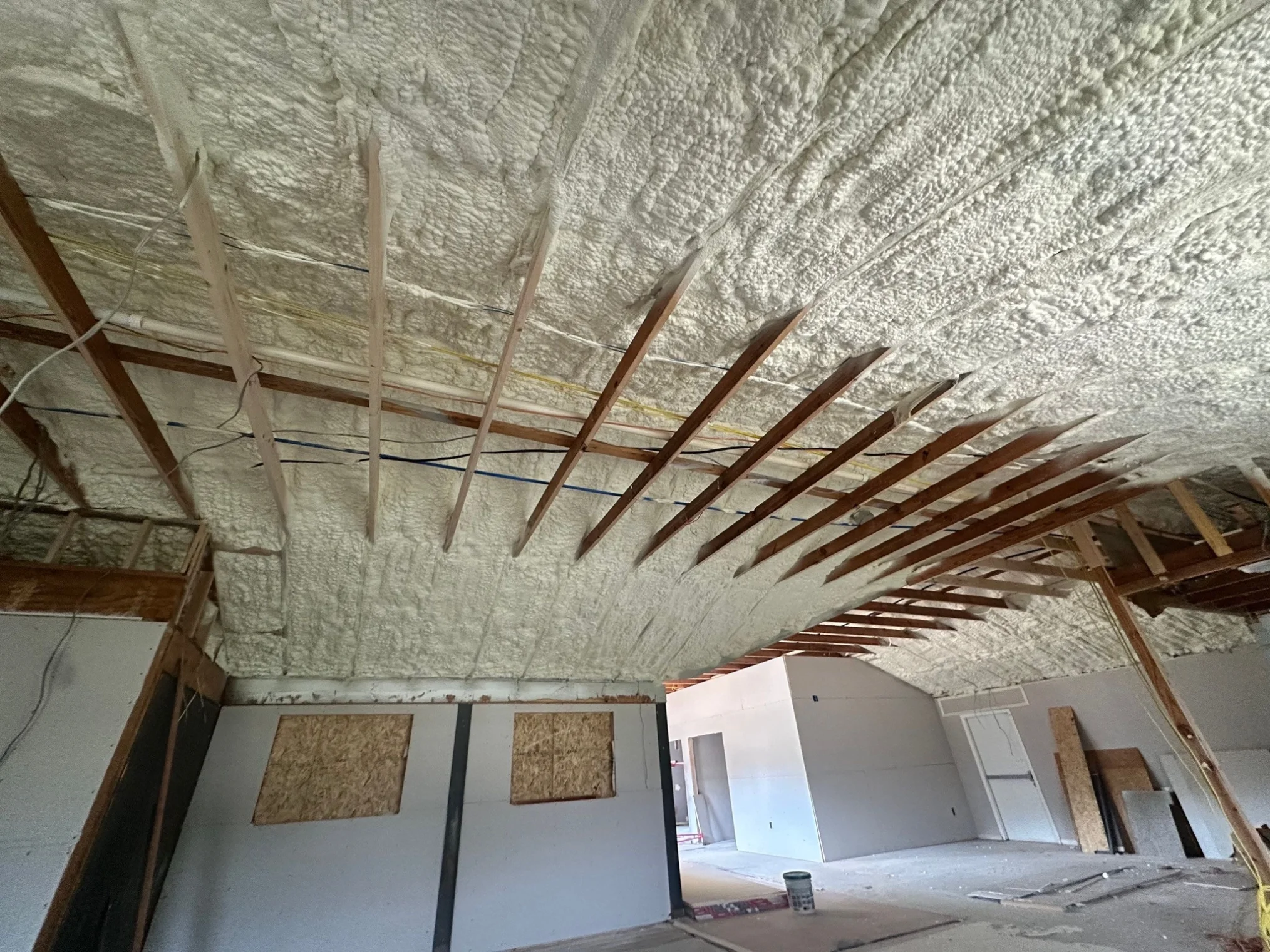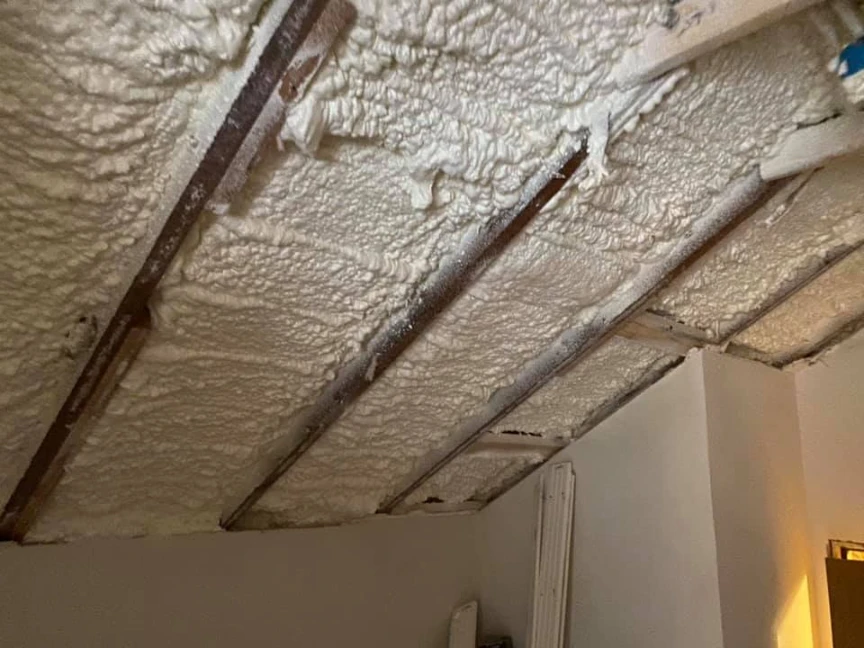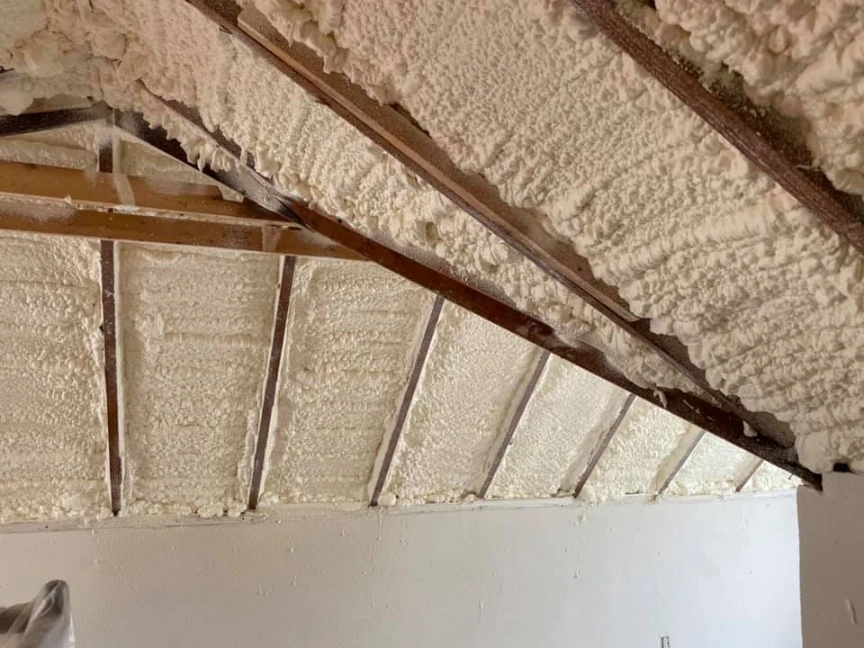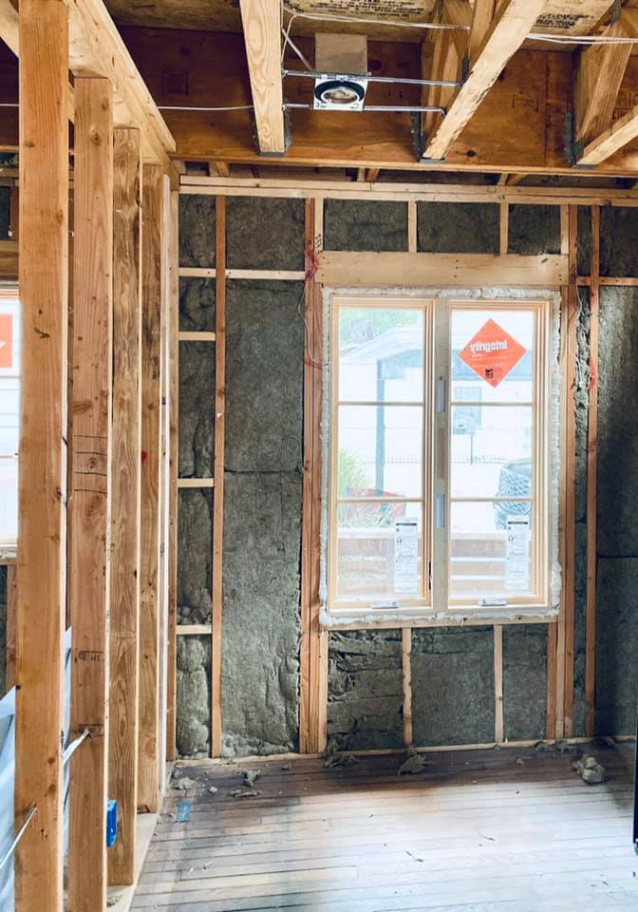Spray foam insulation helps keep indoor air fresher by creating a nearly impenetrable air seal. Unlike traditional insulation solutions that simply slow down heat transfer, spray foam expands to fill every crack, gap, and crevice in a building’s structure. This air barrier stops the uncontrolled flow of outdoor air into the home, preventing pollutants, allergens, dust, and moisture from getting inside. By controlling air movement, spray foam directly addresses one of the primary sources of poor indoor air quality, leading to a cleaner and healthier living environment.
The information shared here explains the specific ways spray foam improves air quality, from moisture control to pollutant reduction. These insights come from years of hands-on experience in residential and commercial insulation, providing a practical look at how this material performs in real-world conditions. Understanding these functions is the first step toward creating a home that is not only energy-efficient but also a healthier space for its occupants.
The Critical Role of an Air Barrier
The single greatest advantage of spray foam is its ability to act as an air barrier. Traditional insulation like fiberglass batts or blown-in cellulose sits within wall cavities but does not stop air from passing through them or around them. Air can still travel through tiny construction gaps around plumbing, electrical wiring, and framing. These air leaks are the main pathways for outdoor contaminants to enter a home.
Spray polyurethane foam (SPF) is applied as a liquid that expands, creating a solid, continuous layer that adheres to surfaces. This process seals the building envelope tightly. By stopping air leaks, you significantly reduce the amount of dust, pollen, and other airborne particles that can get indoors. Homeowners often notice a visible reduction in dust accumulation on surfaces after an installation, which is a direct result of this air-sealing capability.
Moisture Management and Mold Prevention
Controlling moisture is essential for maintaining healthy indoor air. When warm, humid air comes into contact with a cold surface, condensation can form, creating the perfect environment for mold and mildew to grow. According to the U.S. Environmental Protection Agency, mold exposure can cause a variety of health effects, including allergic reactions and respiratory issues.
Closed-cell spray foam, in particular, acts as a vapor barrier, resisting the passage of moisture through the material itself. Because it creates a tight seal and doesn’t absorb water, it helps keep wall cavities dry. This eliminates the damp conditions that mold and mildew need to survive.
- Bonus Tip: In high-humidity areas like crawl spaces or basements, using closed-cell spray foam can be especially effective. It prevents ground moisture from seeping into the home’s structure, which is a common source of musty odors and poor air quality.
How Insulation Types Compare on Air Quality
Not all insulation materials offer the same benefits for indoor air. The primary difference lies in their ability to control airflow and moisture, which are the two biggest factors affecting airborne contaminants.
| Feature | Spray Foam Insulation | Fiberglass Insulation | Cellulose Insulation |
|---|---|---|---|
| Air Sealing Ability | Excellent (forms a complete air barrier) | Poor (does not stop airflow) | Fair (reduces airflow but does not seal) |
| Moisture Resistance | Excellent (closed-cell is a vapor barrier) | Poor (can absorb and hold moisture) | Poor (can absorb moisture, may slump) |
| Allergen Blocking | Excellent (seals out pollen and dust) | Poor (air passes through, bringing allergens) | Fair (denser than fiberglass, but still allows air) |
| Mold Resistance | Excellent (does not provide a food source) | Fair (paper facing can support mold) | Poor (made of organic material) |
This comparison shows that while fiberglass and cellulose provide thermal resistance, they do not create the comprehensive air and moisture barrier that spray foam does.
Reducing Outdoor Pollutants and Odors
A home’s proximity to busy roads, industrial areas, or agricultural land can expose it to a variety of external pollutants. A report from the U.S. Department of Energy explains that air sealing is a key strategy for improving indoor air quality by keeping these pollutants out. Contaminants like vehicle exhaust, pesticides, and unpleasant odors can easily infiltrate a home through small gaps in the building envelope.
By creating a durable air seal, spray foam effectively blocks these airborne pollutants from entering. This is particularly noticeable for people living near high-traffic areas who often report a decrease in outdoor smells and a general sense of “cleaner” air inside their homes after upgrading their insulation.
Things to Consider Before Making a Decision
Choosing the right insulation involves more than just its performance characteristics. Proper spray foam installation and system planning are just as important for achieving good indoor air quality.
Open-Cell vs. Closed-Cell Foam
Both types of spray foam create an air barrier, but they have different properties. Open-cell foam is lighter, less dense, and provides excellent sound dampening. Closed-cell foam is rigid, denser, and acts as a vapor barrier, making it better for moisture control. The choice depends on the application area (walls vs. crawl space) and the local climate.
The Importance of Professional Installation
The benefits of spray foam are entirely dependent on correct installation. An improperly applied foam can result in gaps, poor adhesion, or an incorrect mixture, which compromises its performance. It’s important to work with certified installers who follow strict safety protocols and application guidelines to ensure the foam cures correctly and functions as intended.
- Bonus Tip: Always ensure the installation team uses proper ventilation during and immediately after the application process. The foam needs time to cure fully, and good airflow is necessary for this process. Occupants should typically plan to be away from the home for 24 to 48 hours.
Mechanical Ventilation Needs
Because spray foam makes a home so airtight, it’s often necessary to incorporate a mechanical ventilation system, such as an Energy Recovery Ventilator (ERV) or a Heat Recovery Ventilator (HRV). These systems introduce fresh, filtered air from the outside in a controlled manner while exhausting stale indoor air. This ensures a constant supply of fresh air without sacrificing energy efficiency.
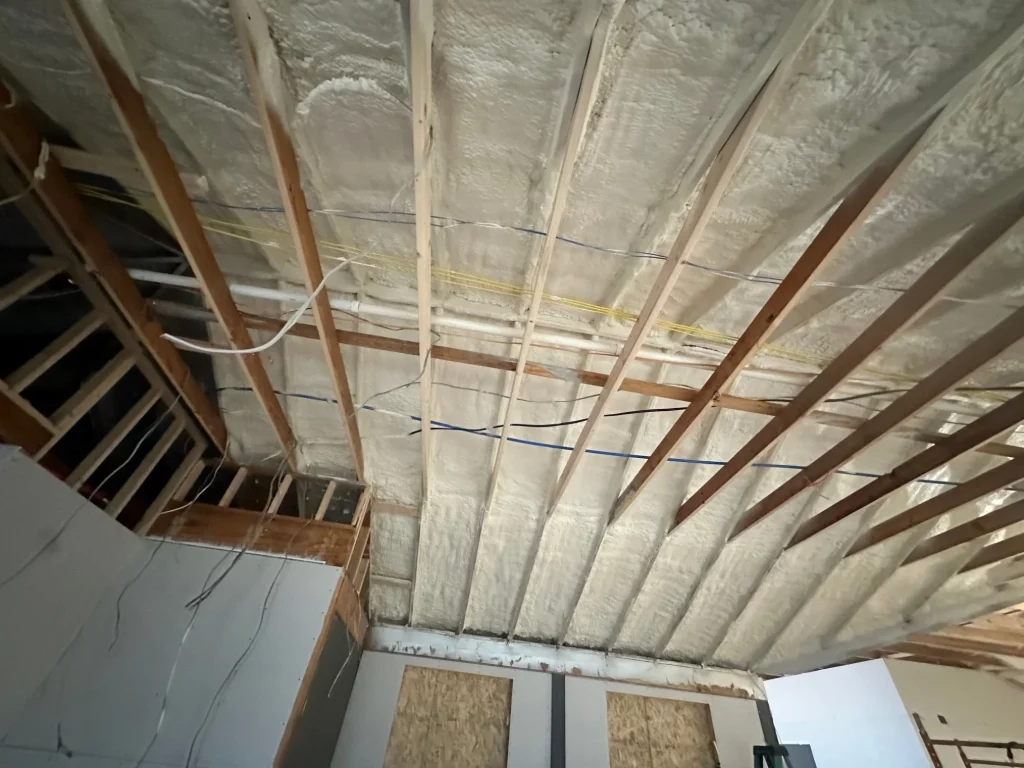
Frequently Asked Questions About Spray Foam
Does spray foam release harmful chemicals?
Modern spray foams are formulated to be stable and inert once fully cured. During the application and curing process, volatile organic compounds (VOCs) are released. Information from the Centers for Disease Control and Prevention confirms that once spray foam is fully cured, it is considered inert and no longer poses an exposure risk. This is why it is standard practice for occupants to vacate the premises for at least 24 hours while this curing takes place.
Is spray foam a good choice for people with allergies or asthma?
Many people with respiratory conditions find relief in homes insulated with spray foam. By sealing out pollen, dust, and other environmental allergens, it can significantly reduce indoor triggers. The material itself is also inert and does not shed fibers or particles that could irritate the respiratory system.
Can spray foam be installed in an existing home?
Yes, spray foam is commonly used in retrofitting existing homes. It can be injected into wall cavities or applied to open surfaces like attic floors, crawl space walls, and rim joists to greatly improve the home’s air seal and thermal performance.
How does spray foam affect an HVAC system?
By creating an airtight envelope, spray foam reduces the workload on an HVAC system. The system doesn’t have to run as often to maintain the desired temperature because conditioned air isn’t escaping and outside air isn’t getting in. This can lead to longer equipment life and may allow for smaller, more efficient HVAC units when it’s time for a replacement.
Does spray foam insulation deter pests?
Closed-cell spray foam creates a solid, hard barrier that is difficult for insects and rodents to chew through. It also seals the cracks and holes that pests often use to enter a home. While not a pesticide, its physical properties make it an effective pest deterrent.
What is the typical lifespan of spray foam?
Spray foam insulation is a durable material that does not sag, settle, or decompose over time. When installed correctly, it should last for the life of the building, maintaining its air-sealing and insulating properties without needing replacement.
Final Thoughts and Next Steps
Improving indoor air quality is about controlling what gets into your home. Spray foam insulation provides a unique advantage by creating a robust air seal that blocks the primary pathways for pollutants, allergens, and moisture. This results in a cleaner, fresher, and healthier indoor environment year-round. Before deciding on any insulation, it’s a good idea to assess your home’s specific vulnerabilities and long-term goals for both energy efficiency and air quality. For a detailed evaluation of your home’s insulation needs and to understand how to improve your indoor air quality, it’s best to consult with specialists. The team at Stellrr Insulation & Spray Foam can provide a thorough assessment and answer your questions. Contact us by calling (512) 710-2839 or sending an email to info@stellrr.com to discuss your specific situation. A well-planned insulation strategy is a foundational step toward a healthier home.
Click to learn more about Stellrr Insulation & Spray Foam’s latest initiatives in delivering top-tier insulation solutions for improved indoor environments.
Sources
- U.S. Environmental Protection Agency – Provides comprehensive information on mold, its health effects, and strategies for prevention and cleanup in homes.
- U.S. Department of Energy – Offers detailed guidance on the benefits of air sealing a home to improve energy efficiency and indoor air quality.
- Centers for Disease Control and Prevention – Offers safety information regarding spray polyurethane foam, including details on the curing process and potential chemical exposures.


